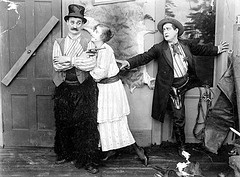Pre-production
Filmmaking is a unique artistic endeavor that covers visual and auditory human expression. It can be a long and difficult journey. Although some people believe they can complete nearly every task it takes to make a good film, it’s often more efficient to employ others to work in sync.
Every film begins with an idea. This idea is often turned into a logline created by the writer. A logline is single sentence that sums up the entire film in one tight package.
From the logline, the writer will often develop the plot with an outline. Film plot almost always follows a traditional three-act structure. Writers may draw from traditional plot-types and journey’s, as well as character archetypes when developing an outline.
From the outline, production of the script will begin. Screenplay’s follow strict formatting guidelines and will usually run an average of 90 to 110 pages for a feature film.
Short films are generally limited to about forty minutes, but it’s my opinion that two to five minutes is ideal for a short.
Production
Production is the phase many people think of when they envision filmmaking. There are a few key players that every film should have, no matter how small. The director, the actor, cinematographer, production sound, and production design.
Actors are a given. They are the people every person sees when watching a film. Actors can be professionals, often based on talent or marketing potential. Some artistic filmmakers prefer to cast non-actors in their films (believe, for instance, that an actual police officer would portray a police officer better than an actor could).
The director is perhaps one of the most important workers on a production.
They are often there from the start, and are responsible for the overall coordination of workers on the film. The success or failure of a film is often pinned on the director.
The cinematographer, or “Director of Photography” is responsible for the camera work. The DP (short for Director of Photography) will sometimes run the camera themselves, or they may hire camera operators. They are responsible for lighting design and film exposure. Lens choice is an artistic choice that the director may want control of; but sometimes, the DP will choose the lens.
Good production sound is important. Although dialogue can be re-recorded in a studio, it’s often better to get it right from the start. If shooting video, a boom operator may attach a microphone directly into the camera. Otherwise, a separate audio recorder may be used and put into sync with the film later.
Production designers are often overlooked in filmmaking. They are responsible for look of film sets and costumes. Oftentimes, you won’t see these people working on short films, but when they do, it has a huge impact.
Post Production
After the film is shot, we reach the editing stage. Nowadays, most editing is done digitally on a computer. If you shot video, it can be loaded right into the computer. If you shot film, the film processor will likely transfer it to a videotape for editing.
There are three important stages to video editing. Editing the images and dialogue is the first phase, and for many amateurs, the last. Shot order can be used to create different effects, and shot lengths can create an artistic beat similar to a musical beat.
When the video edit is finalized, a sound designer will often go through and add ambient sound and effects for emphasis and continuity. This is an important stage many beginners forget! Sound may be recorded or taken from an effects CD.
Once the visuals and sound effects are complete, a soundtrack can be added. Many filmmakers tend to overdo the music in filmmaking. A lack of music can add realism; check out No Country For Old Men to see how.
Learn more on filmmaking at the authors personal film blog. View his short films.
Question by : Can political art be unbiased? What is the responsibilit of filmmakers to be historically accurate when basing?
Can political art be unbiased? What is the responsibilty of filmmakers to be historically accurate when basing their stories on real-life events?
Best answer:
Answer by ash
Not sure, if there is a disclaimer then they can do what they want. I heard someone complain that Disney’s “Pocahontas” was not historically accurate; they shut up when someone else pointed out that it also contained a talking raccoon.
What I am saying is, if a nation depends on movies for their history lessons then we are in a truly sorry state.
Give your answer to this question below!
[wpramazon asin=”0240812069″]
Ryan reviews three cameras priced under 00 and tests out some sexy slow-mo. If you’re looking for a great camera, but don’t want to spend a lot, this is the episode for you!
